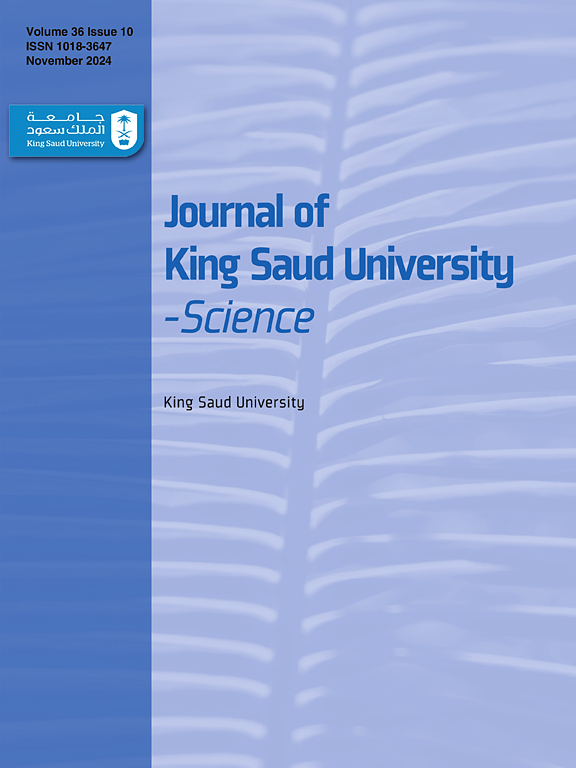种子接种日本根瘤菌可改善不同大豆(Glycine max L.)基因型的脂肪酸组成
IF 3.6
3区 综合性期刊
Q1 MULTIDISCIPLINARY SCIENCES
引用次数: 0
摘要
背景大豆是粮食安全的重要作物,因为它能满足全球对油料的需求。种子接种细菌经常被用来提高大豆产量,但这可能会改变种子的成分。然而,基因型对细菌的反应各不相同。因此,有必要评估根瘤菌对种子成分的影响。方法这项为期两年(2018 年和 2019 年)的研究调查了种子接种日本根瘤菌对不同大豆基因型脂肪酸成分的影响。本研究包括三种经常种植的大豆基因型,即'Gapsoy16′、'Traksoy'和'İlksoy'。这些种子有的接种了 R. japonicum,有的没有接种。测定了脂肪酸谱,即饱和脂肪酸(棕榈酸和硬脂酸)和不饱和脂肪酸(油酸、亚油酸、亚麻酸和花生酸),并对收集的数据进行了单变量和多变量分析。亚油酸、油酸和棕榈酸占种子总脂肪酸的 33%。亚油酸含量在 30.78-34.02 % 之间变化,而油酸含量在 27.85-31.04 % 之间变化。同样,棕榈酸的含量在 15.53-16.93 % 之间。İlksoy "和 "Gapsoy "的棕榈酸和油酸含量分别最高。总之,接种细菌增加了不饱和脂肪酸的含量,降低了饱和脂肪酸的含量。然而,'İlksoy'基因型的不饱和脂肪酸含量有所下降。因此,'Traksoy'可以接种日本酵母菌来改善脂肪酸组成。本文章由计算机程序翻译,如有差异,请以英文原文为准。
Seed inoculation with Rhizobium japonium bacteria improved fatty acid composition of different soybean (Glycine max L.) genotypes
Background
Soybean is an important crop for food security as it fulfills global oil requirements. Seed inoculation with bacteria is frequently used to increase its production; however, it could change the seed composition. Nevertheless, the genotypes respond differently to the bacteria. Therefore, it is necessary to assess the impact of Rhizobium bacteria on the seed composition.
Methods
This two-year (2018 and 2019) study investigated the effects of seed inoculation with Rhizobium japonicum on fatty acid composition of different soybean genotypes. Three frequently cultivated soybean genotypes, i.e., ‘Gapsoy16′, ‘Traksoy’, and ‘İlksoy’ were included in the study. The seeds were either inoculated with R. japonicum or sown without inoculation. The fatty acid profile, i.e., saturated fatty acids (palmitic and stearic acid) and unsaturated fatty acids (oleic, linoleic, linolenic, and arachidic acids) was determined, and the collected data were analyzed by single and multivariate analysis.
Results
Seed inoculation with R. japonicum significantly altered the fatty acid composition of different genotypes; however, varied effects were recorded for the genotype. Linoleic acid, oleic acid, and palmitic acid made up ∼ 33 % of total fatty acids in seeds. Linoleic acid contents varied between 30.78–34.02 %, whereas oleic acid contents ranged between 27.85–31.04 %. Similarly, palmitic acid contents differed between 15.53–16.93 %. The ‘İlksoy’ and ‘Gapsoy’ had the highest contents of palmitic and oleic acids, respectively. Overall, inoculation of bacteria increased the composition of unsaturated fatty acids and lowered saturated fatty acids.
Conclusion
Seed inoculation with R. japonicum increased the essential fatty acid composition in ‘Traksoy’ genotype. However, ‘İlksoy’ genotype recorded a decrease in unsaturated fatty acids. Therefore, ‘Traksoy’ can be inoculated with R. japonicum to improve fatty acid profile.
求助全文
通过发布文献求助,成功后即可免费获取论文全文。
去求助
来源期刊

Journal of King Saud University - Science
Multidisciplinary-Multidisciplinary
CiteScore
7.20
自引率
2.60%
发文量
642
审稿时长
49 days
期刊介绍:
Journal of King Saud University – Science is an official refereed publication of King Saud University and the publishing services is provided by Elsevier. It publishes peer-reviewed research articles in the fields of physics, astronomy, mathematics, statistics, chemistry, biochemistry, earth sciences, life and environmental sciences on the basis of scientific originality and interdisciplinary interest. It is devoted primarily to research papers but short communications, reviews and book reviews are also included. The editorial board and associated editors, composed of prominent scientists from around the world, are representative of the disciplines covered by the journal.
 求助内容:
求助内容: 应助结果提醒方式:
应助结果提醒方式:


